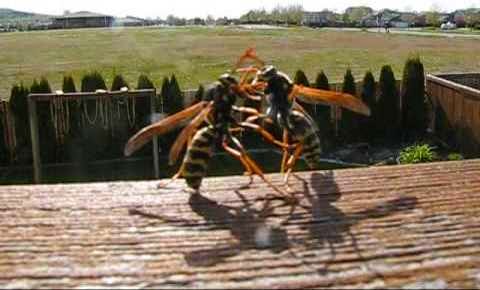30 October 2014
Someone
once said, “Only the dead have seen the end of war.” But he was talking about people, not about
bees. But, I guess, organized societies
of insects have some of the same issues as organized societies of people.
The place is Austrialia. The problem: a protracted war between the Carbonaria’s and the Hockings'. These aren't two feuding families like the Hatfield’s and McCoy’s or the Montague’s and the Capulet’s. These are two different two different species of Tetragonula bees. And they just won’t stop fighting.
The place is Austrialia. The problem: a protracted war between the Carbonaria’s and the Hockings'. These aren't two feuding families like the Hatfield’s and McCoy’s or the Montague’s and the Capulet’s. These are two different two different species of Tetragonula bees. And they just won’t stop fighting.
For several years, now, at a certain
time of the year, Australian residents have been seeing large swarms around tree hives. These clouds are, actually, large battling swarms of worker
bees fighting to the death. Some “battle
clouds” of bees have even hovered uncomfortably close to residents’ homes. And
the owners of about 600 of these homes, who keep hives of bees as pets, are concerned to the
point of upset over the on-going battles around their hives.
No Pacifist Bees?
You might think that friendlier
strains of bees might be found and kept as pets. Maybe hives filled with one of
the unusual, though not rare, breeds of stingless bees might be the
answer. Surely a stingless bee would be
more docile and peace-loving than its stinging cousins?
Guess again.
The Tetragonula bee is a genus of stingless bee. So, both the Carbonaria’s and the
Hockings’
are as “disarmed” as bees get. Stingless
or not, they have no trouble fighting to the death. Anyone standing under one of those bee
“battle-clouds” suffers a rain of dead bees all around them, as casualties
of the battle tumble out of the air to the ground. The battling worker bees grab and
hold each other – locked in a sort of “death-grip” -- until both combatants
die.
Invaders from the
North?
In one particularly active
season of conflict, investigators watched as three waves of invading Hockings bees descended from the North
to lay siege to many surprised hives of Carbonaria
bees.
Graceless in Victory
The Hockings invaders from the
North seem to be winning the war, battle by battle, taking over hive after hive
of the defeated Carbonaria’s. The winning northern invaders promptly move
into the hives of the defeated enemy installing their own queen and taking
possession of the hive’s honey and pollen stores as the spoils of war. Enemy stragglers are dealt with swiftly as
the Hockings bees drag any
remaining Carbonaria workers and
“youngsters” out of the hive to complete the enemy eviction.
Barbarian Bees From
the North?
The Carbonaria’s honey and pollen stores were only part of what
attracted the opportunistic Hockings
bees from the North. The Cabonariea’s refined style of
architecture, including orderly spiral shaped nests, were envied by their
Northern neighbors whose own hive architecture and maintenance is more
chaotic.
Investigators
can clearly identify the captured hives by observing the clear deterioration in
style, maintenance and repair of the former Carobonaria
hives that have fallen into the hands (or whatever) of the barbarian bees from
the North.
The Criminal Culture
of the South American Tetroganula Bees
Just because the hives aren't
worth taking doesn't mean your bee colony is safe. In South America, bees of the same Tetragonula
genus don’t even bother with their victims’ hives. The South American species just attack and clean
out the enemy hive’s honey and pollen stores.
And these
aren't wayward individual bees, fallen on hard times, who “pinch” a little
honey for a much needed meal. Bees are
organized. And their crime is organized crime! Not only have these South American crime
colonies become organized honey robbers, cleaning out all the stores of honey
and pollen from victim hives, but they, also, leave no witnesses from the victimized hives.
M Grossmann of Hazelwood ,
Missouri
& Belleville, Illinois





Thanks for this. I really like what you've posted here and wish you the best of luck with this blog and thanks for sharing. Local honey houston
ReplyDelete